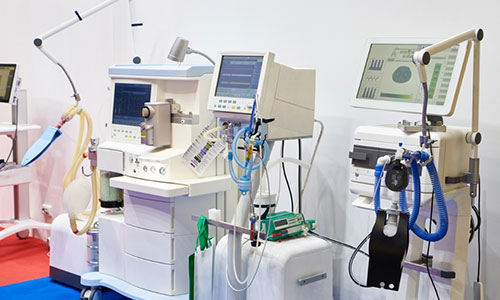Medical ventilators: the components and sensors needed in essential medical care
A form of life support treatment, medical ventilators are vital for assisting with a patient’s breathing when they are unable to breathe sufficiently on their own. Rodrigue Mao, Head of Product Management, Distrelec looks at the basic components that are common to all ventilators.
This article originally appeared in the April '22 magazine issue of Electronic Specifier Design – see ES's Magazine Archives for more featured publications.
Sensors
Sensors act as quality monitors to ensure that the ventilator is operating efficiently and that the incoming air is at the correct composition for the patient. Characteristics such as pressure, volume and oxygen levels are all measured and monitored by sensors. Safety-critical sensors are connected to printed circuit boards and controlled by software.The following subsections cover the essential characteristics that are monitored.
Gas concentration
As ventilators are used to assist with breathing, several gases are inhaled and exhaled by the patient and may be required in differentamounts. Where quantities of each gas are specified by a doctor, airflow sensors can be used to ensure that the desired and correct combination is delivered to the patient. This information is then measured and displayed on the ventilator panel.
Temperature
Installed directly into the air stream, thermistor sensing elements and packaged temperature probes are designed to monitor the air temperature. As sore throats can be caused by breathing in cold, dry air, ventilators try to mitigate this by using warm, moist air to help patients breathe more comfortably. By controlling and monitoring the temperature of the air delivery system, a desired level of warmth can be provided. This is achieved by using a microcontroller to measure and regulate the air stream temperature accordingly.
Pressure
To ensure that desired pressure levels are not exceeded, board mount pressure sensors can be used to measure air and oxygen pressure. Heavy duty pressure transducers are particularly useful where high pressure, steel pressure port interface and/or corrosive media are used.
Humidity
Capable of measuring the delivery of warm and moist air, humidity sensors enhance patient comfort. Having the ability to monitor any moisture in the air stream is vital for controlling moisture levels to maximise patient comfort.
Pneumatic circuits
Fundamentally, pneumatic circuits consist of the tube, fittings, in-line valves and regulators. Regulators that are typically included in a ventilator are detailed in the following subsections.
Expiratory pressure regulator (PEEP valve)
This maintains and controls positive airway pressure with carefully controlled expiratory flow obstructions that are usually in the form of a solenoid valve.
Inspiratory flow regulator This type of regulator ensures that the respiratory circuit receives the correct, prescribed gas flow. Typically, solenoid valves are used for this purpose and are located in front of the gas supply where they are best placed to ensure that patients only receive carefully measured amounts of gas.
Actuators
Actuators provide corrective action when measured parameters fall out of range. Typical examples of actuators within ventilators include pressure valves and flow control valves. Pressure regulators, for instance, are self-contained valves and actuator combinations that can be used to restrict and limit flow as required.
Consumables
Used by clinicians, consumables are parts that are disposed of after use. They include self-inflating bags, filters, and adhesive tape.
Programmable logic controllers
Ideal for intelligent air control systems, programmable logic controllers optimise the efficiency of ventilation systems by monitoring and regulating according to demand and by providing corrective action as required.
This is made possible with input and output (I/O) channels which are connected to sensors and actuators. Designed to operate automatically, many PLCs can also be configured for cleaning and maintenance.

Creative solutions for a common problem
Medical ventilators are a critical resource that have been in short supply due to the COVID-19 pandemic. As these machines are vital to facilitate breathing for the sickest patients, meeting the increase in demand is essential. To meet this need, innovative engineers from a plethora of industries pulled together to create ventilator parts.
In the UK, the Department for Health & Social Care provided ventilator blueprints to military engineers and car manufacturers. Manufacturers such as Fiat, Nissan, General Motors, Ford and Tesla started converting their plants to help produce ventilators. Vauxhall offered to help with the 3D printing of ventilator parts and several UK-based Formula One teams mobilised their workforces to help with production.
Dyson has also been working on this project, learning about the challenges in designing ventilators and finding solutions to manufacture the parts required.
While this challenge is a huge one, engineers and manufacturers are striving to help, by using the resources that they have and exploring the many opportunities at their disposal.










